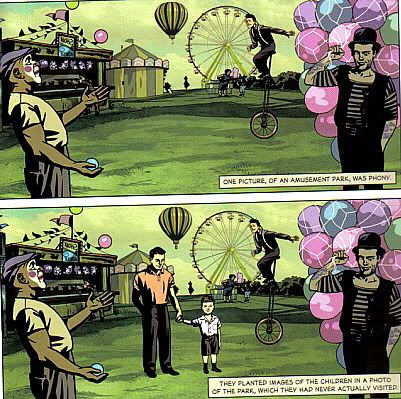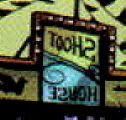Book-It 'o9! Book #10
More of the Fifty Books Challenge! This was a library request.

Title: Waltz with Bashir by Ari Folman and David Polonsky
Details: Copyright 2009, Metropolitan Books
Synopsis (By Way of Product Description Offered By Publisher): One night in Beirut in September 1982, while Israeli soldiers secured the area, Christian militia members entered the refugee camps of Sabra and Shatila and began to massacre hundreds, if not thousands, of Palestinians. Ari Folman was one of those Israeli soldiers, but for more than twenty years he remembered nothing of that night or of the weeks leading up to it. Then came a friend’s disturbing dream, and with it Folman’s need to excavate the truth of the war in Lebanon and answer the crucial question: what was he doing during the hours of slaughter?
Challenging the collective amnesia of friends and fellow soldiers, Folman painfully, candidly pieces together the war and his place in it. Gradually, the blankness of his mind is filled in by scenes of combat and patrol, misery and carnage, as well as dreams and hallucinations. Soldiers are haunted by inexplicable nightmares and flashbacks-snapping, growling dogs with teeth bared and eyes glowing orange; a recurring image of three young men rising naked out of the sea to drift into the Beirut battlefield. Tanks crush cars and buildings with lethal indifference; snipers pick off men on donkeys, men in cars, men drinking coffee; a soldier waltzes through a storm of bullets; rock songs fill the air, and then yellow flares. The recollections accumulate until Ari Folman arrives at Sabra and Shatila and his investigation reaches its terrible end.
Why I Wanted to Read It: Whenever an animated intended-for-adults film turns up, such as this or Persepolis, I always perk up since A)I'm fascinated by "this sort of thing" and B)I feel a strange need to support the legitimizing of graphic novels, particularly since I'm trying to write a couple. This I assumed was the book that the film was based upon (ala Persepolis) and since I wanted to see the film, I figured I'd read this first.
How I Liked It: This actually isn't the book the film is based on. It's the other way around, as bizarre as that sounds. The art alone in the book is absolutely exquisitely done (tricky to say about a book dealing with the utter atrocity of war). At first this seemed to me (through projection?) to deal more with psychology and trauma rather than war. Ari Folman is trying to piece together his scattered and repressed memory of the war, seeking aid from his "shrink-friend", who suggests he seek out those who were there with him and can help him piece together his missing memories. Each individual reflects on his memory (they're all men) of the events involving Folman and in doing so, each reveals a horrific vignette of the war. Ultimately, Folman find his memory, and thus the culmination of the story. But how it's done is what's truly amazing. The entire story is told through animation... up until Folman retrieves his repressed memory. The Sabra and Shatila refugee camps are shown in photograph, rather than illustration like the rest of the novel. Genius.
I can only wonder how this is going to work in the film and if it will be told similarly.
Notable: I can find almost no press for the graphic novel itself aside from a listing at (what else) Amazon. The illustrator (who also worked on the film) David Polonsky has no Wiki entry and there's no entry for the book despite the massive listing for the film. Despite being a fully formed novel in and of itself, the book seems to almost be some sort of promotional device for the film. The back cover of the book is decorated with "early acclaim for the film" snippets. Perhaps the creators felt that they couldn't sell the film since it was animated without having a graphic novel, therefore somehow "justifying" the fact the film is set with animation? Perhaps.
Much smaller, but still interesting to note:
On page fifteen, Folman is visiting with his "shrink-friend" who is telling him about a well-known experiment in psychology. His friend describes the experiment and an interesting possible blip shows up in the panels. This is how it appears in the book:

Now look at the "Shoot House" to the left of the frame in both panels. The words appear to be backwards.

I'm going to guess that Polonsky had the artwork of the amusement park ready and when they were adding the dialog script they decided flip it, and for whatever reason, this got missed. Or was left, since the slant makes it a tricky flip (for comparison's sake I was going to flip it, and though I'm sure Polonsky has access to far higher quality software than I do, I bet it would still be sufficiently annoying enough to just leave) and hey, who's going to notice something like that anyway?
An dopey art geek soaking up minute details of the technique, that's who.

Title: Waltz with Bashir by Ari Folman and David Polonsky
Details: Copyright 2009, Metropolitan Books
Synopsis (By Way of Product Description Offered By Publisher): One night in Beirut in September 1982, while Israeli soldiers secured the area, Christian militia members entered the refugee camps of Sabra and Shatila and began to massacre hundreds, if not thousands, of Palestinians. Ari Folman was one of those Israeli soldiers, but for more than twenty years he remembered nothing of that night or of the weeks leading up to it. Then came a friend’s disturbing dream, and with it Folman’s need to excavate the truth of the war in Lebanon and answer the crucial question: what was he doing during the hours of slaughter?
Challenging the collective amnesia of friends and fellow soldiers, Folman painfully, candidly pieces together the war and his place in it. Gradually, the blankness of his mind is filled in by scenes of combat and patrol, misery and carnage, as well as dreams and hallucinations. Soldiers are haunted by inexplicable nightmares and flashbacks-snapping, growling dogs with teeth bared and eyes glowing orange; a recurring image of three young men rising naked out of the sea to drift into the Beirut battlefield. Tanks crush cars and buildings with lethal indifference; snipers pick off men on donkeys, men in cars, men drinking coffee; a soldier waltzes through a storm of bullets; rock songs fill the air, and then yellow flares. The recollections accumulate until Ari Folman arrives at Sabra and Shatila and his investigation reaches its terrible end.
Why I Wanted to Read It: Whenever an animated intended-for-adults film turns up, such as this or Persepolis, I always perk up since A)I'm fascinated by "this sort of thing" and B)I feel a strange need to support the legitimizing of graphic novels, particularly since I'm trying to write a couple. This I assumed was the book that the film was based upon (ala Persepolis) and since I wanted to see the film, I figured I'd read this first.
How I Liked It: This actually isn't the book the film is based on. It's the other way around, as bizarre as that sounds. The art alone in the book is absolutely exquisitely done (tricky to say about a book dealing with the utter atrocity of war). At first this seemed to me (through projection?) to deal more with psychology and trauma rather than war. Ari Folman is trying to piece together his scattered and repressed memory of the war, seeking aid from his "shrink-friend", who suggests he seek out those who were there with him and can help him piece together his missing memories. Each individual reflects on his memory (they're all men) of the events involving Folman and in doing so, each reveals a horrific vignette of the war. Ultimately, Folman find his memory, and thus the culmination of the story. But how it's done is what's truly amazing. The entire story is told through animation... up until Folman retrieves his repressed memory. The Sabra and Shatila refugee camps are shown in photograph, rather than illustration like the rest of the novel. Genius.
I can only wonder how this is going to work in the film and if it will be told similarly.
Notable: I can find almost no press for the graphic novel itself aside from a listing at (what else) Amazon. The illustrator (who also worked on the film) David Polonsky has no Wiki entry and there's no entry for the book despite the massive listing for the film. Despite being a fully formed novel in and of itself, the book seems to almost be some sort of promotional device for the film. The back cover of the book is decorated with "early acclaim for the film" snippets. Perhaps the creators felt that they couldn't sell the film since it was animated without having a graphic novel, therefore somehow "justifying" the fact the film is set with animation? Perhaps.
Much smaller, but still interesting to note:
On page fifteen, Folman is visiting with his "shrink-friend" who is telling him about a well-known experiment in psychology. His friend describes the experiment and an interesting possible blip shows up in the panels. This is how it appears in the book:

Now look at the "Shoot House" to the left of the frame in both panels. The words appear to be backwards.

I'm going to guess that Polonsky had the artwork of the amusement park ready and when they were adding the dialog script they decided flip it, and for whatever reason, this got missed. Or was left, since the slant makes it a tricky flip (for comparison's sake I was going to flip it, and though I'm sure Polonsky has access to far higher quality software than I do, I bet it would still be sufficiently annoying enough to just leave) and hey, who's going to notice something like that anyway?
An dopey art geek soaking up minute details of the technique, that's who.